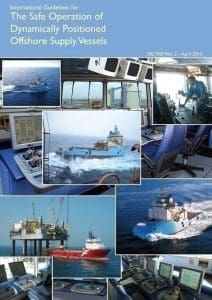
Safe OpDP 182MSF Outside Cover
Reliable and robust methods of positioning are required for safe vessel operations in close proximity to offshore installations. Dynamic positioning (DP) is well-established as a primary method of vessel positioning in the diving, drilling, construction, accommodation and shuttle tanker sectors, and is especially suited to deep-water developments. As development and management of DP becomes more refined, increasingly logistics support vessels are becoming equipped with DP systems with increasing reliance being given to such systems.
With this increased use in mind, the International Marine Contractors Association (IMCA) [Booth S16 at OTC 2015) has published an updated edition of ‘International Guidelines for the Safe Operation of DP Offshore Supply Vessels’.
“The guidelines were originally drawn up by an international cross-industry workgroup, and have recently been updated by the Marine Safety Forum in conjunction with IMCA and the Guidelines for Offshore Marine Operations (GOMO) Group, ” explains IMCA’s Technical Director, Jane Bugler. “Therefore this document is published by IMCA but with an MSF reference (182 MSF). It is freely available for downloading from the IMCA website by members and non-members alike.
“The purpose of these guidelines is to make risk management tools available to vessel operators, charters, masters and officers that will help ensure safe operation of DP offshore supply vessels in automatic DP mode.”
The 48-page guidelines fit into an existing framework of rules and guidance issued by various authorities and organisations. Efforts have been made to ensure compatibility with the existing documents wherever possible.
Jane Bugler adds: “It is recognised that both the DP and offshore supply vessel sectors are constantly evolving. Consequently, these guidelines are only fully relevant to the circumstances in which they were prepared and will have to be updated at least within a three-year cycle to incorporate such changes. We would like to thank all who have contributed to this important document.”
What’s contained in the guidance?
The introduction section of the Guidelines looks at the basis for their production; their application; purpose and scope; and contains useful abbreviations and terms and definitions.
Four other sections follow devoted to ‘Existing Rules and Guidance’; ‘Managing Risk in DP Operations – Competence’; ‘Managing Risk in DP Operations – Operations’; and ‘Managing Risk in DP Operations – Practical Applications’. The appendix contains a wealth of information on relevant publications; DP FMEA and annual trials; annual DP trials; DP capability plot; DP footprint plot; DP vessel specific location checks document; sample DP watchkeeping handover checklist; DP incident reporting; and examples of both critical activity mode of operation (CAMO) and activity specific operating guideline (ASOG).
As well as being available for free download from the IMCA website at www.imca-int.com , copies of the printed Guidelines are available for £10.00 from publications@imca-int.com and from IMCA at 52 Grosvenor Gardens, London SW1W 0AJ, UK. Tel: +44 (0)20 7824 5520; Fax: +44 (0)20 7824 5521.
Further information
Further information on IMCA and its work on behalf of its 1000+ member companies in over 60 countries is available from Booth S16 at OTC 2015, from www.imca-int.com and imca@imca-int.com. The association has LinkedIn and Facebook groups and its Twitter handle is @IMCAint
About IMCA
- IMCA is an international association with well over a thousand members in more than 60 countries representing offshore, marine and underwater engineering companies. IMCA has four technical divisions, covering marine/specialist vessel operations, offshore diving, hydrographic survey and remote systems and ROVs, plus geographic sections for the Asia-Pacific, Central & North America, Europe & Africa, Middle East & India and South America regions. As well as a core focus on safety, the environment, competence and training, IMCA seeks to promote its members’ common interests, to resolve industry-wide issues and to provide an authoritative voice for its members.
- IMCA Vision & Strategy. As a result of work and collective input in 2013, IMCA has redefined its stated core purpose to be “Improving performance in the marine contracting industry”. To achieve this goal, IMCA’s Vision & Strategy has been devised with two elements in mind: Core activities and ways of working.
- IMCA publishes some 200 guidance notes and technical reports – many are available for free downloading by members and non-members alike. These have been developed over the years and are extensively distributed. They are a definition of what IMCA stands for, including widely recognised diving and ROV codes of practice, DP documentation, marine good practice guidance, the Common Marine Inspection Document (CMID) – now available electronically as eCMID, safety recommendations, outline training syllabi and the IMCA competence scheme guidance. In addition to the range of printed guidance documents, IMCA also produces safety promotional materials, circulates information notes and distributes safety flashes.
About the industry IMCA serves
The marine contracting industry plays a vital global role. Its vessels account for 4% of the world’s maritime fleet. Collectively IMCA members employ some 350, 000 people and have an annual turnover of around $150bn. They work in all the world’s major offshore areas, delivering large offshore oil and gas and marine renewables projects around the globe that quite literally fuel the global economy.





